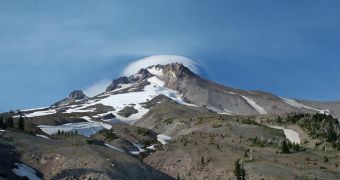According to the conclusions of a new scientific study conducted by researchers at the Oregon State University (OSU), it would appear that volcanoes which have remained dormant for thousands of years can come back to life within a matter of months, a lot faster than previously estimated.
The study, led by OSU geologist Adam Kent and supported by the US National Science Foundation (NSF), was focused on analyzing the magma chamber under Mount Hood, in Oregon. The chamber is located around 5 kilometers (3 miles) underground, and has been in a near-solid state for millennia.
What the team discovered is that the rocks can liquefy again over a very short period of time, even as little as two months. This would make the volcano enter an active state potentially causing an eruption. Mount Hood last erupted 220 and 1,500 years ago.
Kent argues in a new study published in the top journal Nature that these two eruptions were most likely caused by a mixing of near-solid magma in the magma chamber with hot liquid lava climbing from deep underground. Eruptions occur when temperatures exceed 750 degrees Celsius (1,382ºF).
“These scientists have used a clever new approach to timing the inner workings of Mount Hood, an important step in assessing volcanic hazards in the Cascades. If the temperature of the rock is too cold, the magma is like peanut butter in a refrigerator. It isn't very mobile,” says Sonia Esperanca.
The expert holds an appointment as a program director with the NSF Division of Earth Sciences, which sponsored the research. “For Mount Hood, the threshold seems to be about 750 degrees Celsius – if it warms up just 50 to 75 degrees above that, it greatly decreases the viscosity of the magma and makes it easier to mobilize,” she adds.
In the case of Mount Hood, the situation is not particularly dire, since this volcano tends to erupt primarily by oozing magma from its crater. In other parts of the world however, stratovolcanoes can produce devastating blast, putting ash and lava tens of kilometers high in the atmosphere.
“What happens when [the two types of lava] mix is what happens when you squeeze a tube of toothpaste in the middle. Some comes out the top, but in the case of Mount Hood it doesn't blow the mountain to pieces,” Kent concludes.

 14 DAY TRIAL //
14 DAY TRIAL //